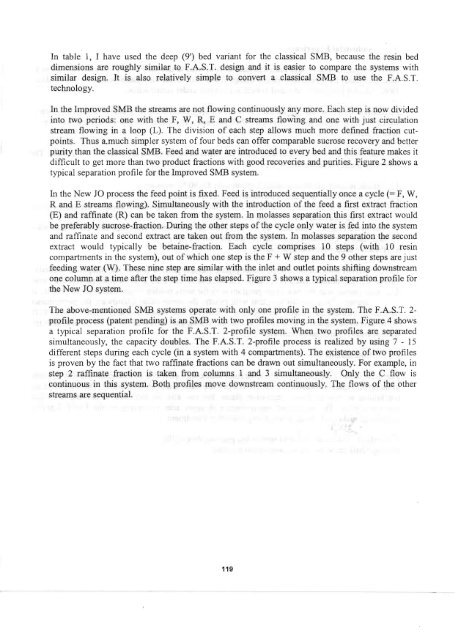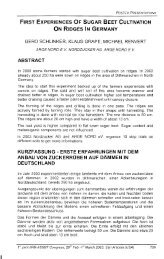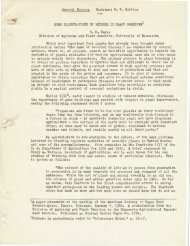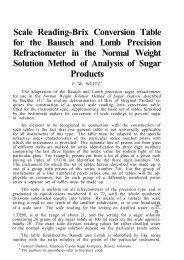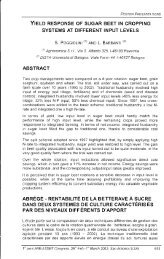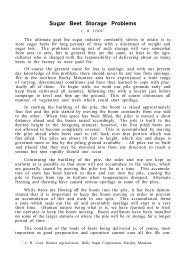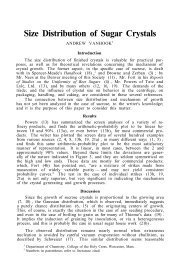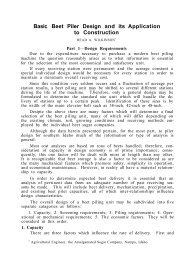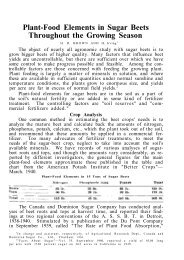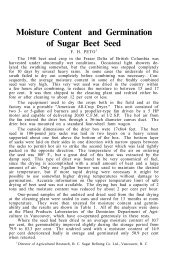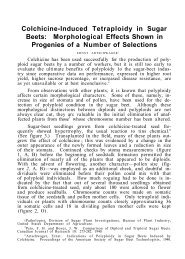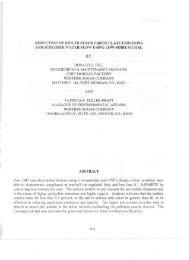New generation of molasses chromatographic separators using ...
New generation of molasses chromatographic separators using ...
New generation of molasses chromatographic separators using ...
You also want an ePaper? Increase the reach of your titles
YUMPU automatically turns print PDFs into web optimized ePapers that Google loves.
In table 1, I have used the deep (9') bed variant for the classical 5MB, because the resin bed<br />
dimensions are roughly similar to F.A.S.T. design and it is easier to compare the systems with<br />
similar design. It is also relatively simple to convert a classical 5MB to use the F.A.S.T.<br />
technology.<br />
In the Improved 5MB the streams are not flowing continuously any more. Each step is now divided<br />
into two periods: one with the F, W, R, E and C streams flowing and one with just circulation<br />
stream flowing in a loop (L). The division <strong>of</strong> each step allows much more defined fraction cutpoints.<br />
Thus a.much simpler system <strong>of</strong> four beds can <strong>of</strong>fer comparable sucrose recovery and better<br />
purity than the classical 5MB. Feed and water are introduced to every bed and this feature makes it<br />
difficult to get more than two product fractions with good recoveries and purities. Figure 2 shows a<br />
typical separation pr<strong>of</strong>ile for the Improved 5MB system.<br />
In the <strong>New</strong> JO process the feed point is fixed. Feed is introduced sequentially once a cycle (= F, W,<br />
Rand E streams flowing). Simultaneously with the introduction <strong>of</strong> the feed a first extract fraction<br />
(E) and raffinate (R) can be taken from the system. In <strong>molasses</strong> separation this first extract would<br />
be preferably sucrose-fraction. During the other steps <strong>of</strong> the cycle only water is fed into the system<br />
and raffinate and second extract are taken out from the system. In <strong>molasses</strong> separation the second<br />
extract would typically be betaine-fraction. Each cycle comprises 10 steps (with 10 resin<br />
compartments in the system), out <strong>of</strong> which one step is the F + W step and the 9 other steps are just<br />
feeding water (W). These nine step are similar with the inlet and outlet points shifting downstream<br />
one column at a time after the step time has elapsed. Figure 3 shows a typical separation pr<strong>of</strong>ile for<br />
the <strong>New</strong> JO system.<br />
The above-mentioned 5MB systems operate with only one pr<strong>of</strong>ile in the system. The F.A.S.T. 2<br />
pr<strong>of</strong>ile process (patent pending) is an 5MB with two pr<strong>of</strong>iles moving in the system. Figure 4 shows<br />
a typical separation pr<strong>of</strong>ile for the F.A.S.T. 2-pr<strong>of</strong>ile system. When two pr<strong>of</strong>iles are separated<br />
simultaneously, the capacity doubles. The F.A.S.T. 2-pr<strong>of</strong>ile process is realized by <strong>using</strong> 7 - 15<br />
different steps during each cycle (in a system with 4 compartments). The existence <strong>of</strong> two pr<strong>of</strong>iles<br />
is proven by the fact that two raffinate fractions can be drawn out simultaneously. For example, in<br />
step 2 raffinate fraction is taken from columns 1 and 3 simultaneously. Only the C flow is<br />
continuous in this system. Both pr<strong>of</strong>iles move downstream continuously. The flows <strong>of</strong> the other<br />
streams are sequential.<br />
119


